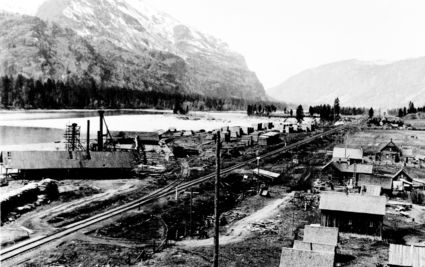Remember When?
December 13, 2018
W.B. RUSSELL TIMBERMAN
By Mike Scott contributor to The Plainsman
William Bruce Russell is best remembered as the Eddy Sawmill man. He learned the timber business as a youth in the New York area. At age sixteen, in 1880, he headed west to seek his fortune. By 1891 he had moved to Thompson Falls where he operated a mill. Late in that year he moved to what was known as Russell Spur on the NP line, a mile east of Eddy. This was an ideal location for a lumber mill for driving logs downriver to the mill and then shipping finished lumber by rail.
W.B., as he was locally known, set about acquiring sizable amounts of land which was for the most part covered with dense stands of pine, fir, western larch and cedar, until he controlled more than 15,000 acres. Much of this acquisition was obtained by his outright purchase of the total package, others by buying only the stumpage. Location of this empire was pretty generally on the south side of the Clark Fork River and usually close to that waterway, encompassing most of the Swamp Creek drainage as far west as Eddy Creek.

One of the finest stands W.B. obtained covered the area farmed by the Stephens and Hermes families and was bought from a man named DuPont. It is reported that the tract which he later cleared and placed under cultivation near the confluence of the Clark Fork and Flathead Rivers produced a total of 12 million board feet of merchantable lumber. He also obtained considerable timberland along the Clark Fork before it joins the Flathead, specifically adjacent to Quinn Springs. Farther upstream the land and its trees were controlled by Ed and Tom Donlan who were engaged in contract logging for the Anaconda Mining Company. Mr. Russell cut his teeth in the western logging game shortly after arriving in these parts when he took a contract to harvest a tract of timber in the Grant Creek area near Missoula. Upon completion of this endeavor he moved his operations to the area that was to become Sanders County. The choice of timber stands near the rivers of the area offered several advantages. First, the more fertile lands on the banks produced larger and better trees. Second, the relatively flat land was advantageous for logging. Third, the streams themselves offered cheap transportation for the annual or semi-annual log drives. Fourth, sawmills were best suited to such an environment, and, finally, towns and eventually railroads were situated near the waterways.
One of the first of W.B.'s logging functions in this locale started on Swamp Creek where he established a camp to accommodate as many as 120 men. This facility was located approximately three miles from the mouth of the creek and near the Tom McCrea home of today. It was here that the entrepreneur built a dam across Swamp Creek, backing the waters up into the present day Fred Cavill ranch. The water was stored primarily for the purpose of controlled flow in order to float the logs downstream to the Clark Fork, a project that was not overly successful according to information sources. Instead it became necessary to skid or haul the logs to the bank of the big river where they were decked and released into the stream when water levels were appropriate, usually in the spring. The logs were then floated to a point near Eddy where they were fished from the water and fed into a large sawmill at that location. This mill was owned by Russell who later sold it to the Donlan brothers.
The Swamp Creek area produced a log which scaled 3,086 board feet, maybe a local record for ponderosa pine. While such logs gave the lumberjacks a topic to brag about along their circuit, they were really a pain in the neck to convert into lumber as their dimension and weight required special gear to get them to the mill and put them through the saws after they arrived.
As time wore on W.B. Russell established other camps on the south side of the Clark Fork River. He operated for a number of years almost directly south of Plains in the Combest and Dry Creek drainages where he established small mills to generate the finished product that had been produced in his large mill at Eddy. It might be noted here that the Eddy location was almost ideal because logs that grew close to the river could be transported to the mill cheaply and the plant situated alongside the railway which furnished a means of moving lumber to eastern markets and to the ACM mines and smelters in Butte and Anaconda. From the Russell mill across the river from town great wagon loads of lumber pulled by four-horse teams began to come.
The product was unloaded along the tracks at the eastern end of Plains. From here much of it went into cars for immediate shipment and some was piled in 20-feet high stacks to dry. After curing, the lumber was run through a planning mill owned by W.O. Burrill that was situated on a spur track just west of the mouth of Boyer Creek. From the planer it usually went into box cars for shipment to Spokane and other markets. The large lumber piles were conspicuous for many years, even after the horse-drawn conveyances were replaced by motorized equipment.




Reader Comments(0)